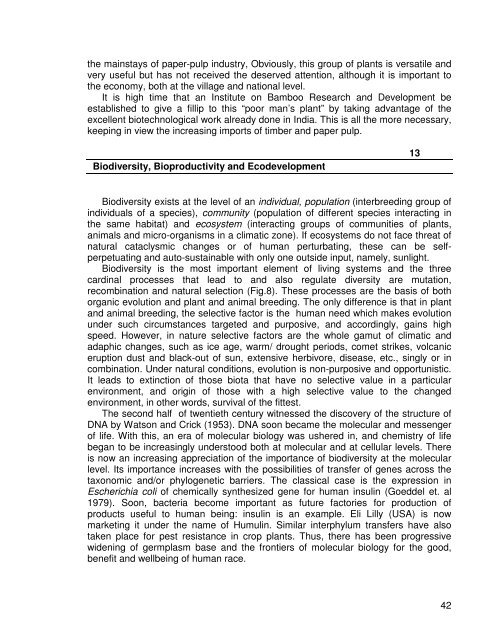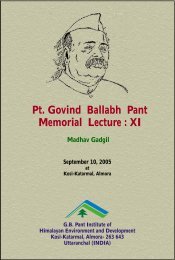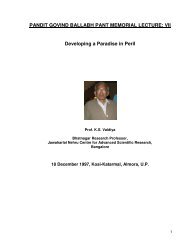Pandit Govind Ballabh Pant Memorial Lecture: II
Pandit Govind Ballabh Pant Memorial Lecture: II
Pandit Govind Ballabh Pant Memorial Lecture: II
You also want an ePaper? Increase the reach of your titles
YUMPU automatically turns print PDFs into web optimized ePapers that Google loves.
the mainstays of paper-pulp industry, Obviously, this group of plants is versatile and<br />
very useful but has not received the deserved attention, although it is important to<br />
the economy, both at the village and national level.<br />
It is high time that an Institute on Bamboo Research and Development be<br />
established to give a fillip to this “poor man’s plant” by taking advantage of the<br />
excellent biotechnological work already done in India. This is all the more necessary,<br />
keeping in view the increasing imports of timber and paper pulp.<br />
Biodiversity, Bioproductivity and Ecodevelopment<br />
13<br />
Biodiversity exists at the level of an individual, population (interbreeding group of<br />
individuals of a species), community (population of different species interacting in<br />
the same habitat) and ecosystem (interacting groups of communities of plants,<br />
animals and micro-organisms in a climatic zone). If ecosystems do not face threat of<br />
natural cataclysmic changes or of human perturbating, these can be selfperpetuating<br />
and auto-sustainable with only one outside input, namely, sunlight.<br />
Biodiversity is the most important element of living systems and the three<br />
cardinal processes that lead to and also regulate diversity are mutation,<br />
recombination and natural selection (Fig.8). These processes are the basis of both<br />
organic evolution and plant and animal breeding. The only difference is that in plant<br />
and animal breeding, the selective factor is the human need which makes evolution<br />
under such circumstances targeted and purposive, and accordingly, gains high<br />
speed. However, in nature selective factors are the whole gamut of climatic and<br />
adaphic changes, such as ice age, warm/ drought periods, comet strikes, volcanic<br />
eruption dust and black-out of sun, extensive herbivore, disease, etc., singly or in<br />
combination. Under natural conditions, evolution is non-purposive and opportunistic.<br />
It leads to extinction of those biota that have no selective value in a particular<br />
environment, and origin of those with a high selective value to the changed<br />
environment, in other words, survival of the fittest.<br />
The second half of twentieth century witnessed the discovery of the structure of<br />
DNA by Watson and Crick (1953). DNA soon became the molecular and messenger<br />
of life. With this, an era of molecular biology was ushered in, and chemistry of life<br />
began to be increasingly understood both at molecular and at cellular levels. There<br />
is now an increasing appreciation of the importance of biodiversity at the molecular<br />
level. Its importance increases with the possibilities of transfer of genes across the<br />
taxonomic and/or phylogenetic barriers. The classical case is the expression in<br />
Escherichia coli of chemically synthesized gene for human insulin (Goeddel et. al<br />
1979). Soon, bacteria become important as future factories for production of<br />
products useful to human being: insulin is an example. Eli Lilly (USA) is now<br />
marketing it under the name of Humulin. Similar interphylum transfers have also<br />
taken place for pest resistance in crop plants. Thus, there has been progressive<br />
widening of germplasm base and the frontiers of molecular biology for the good,<br />
benefit and wellbeing of human race.<br />
42











